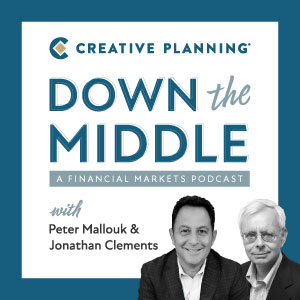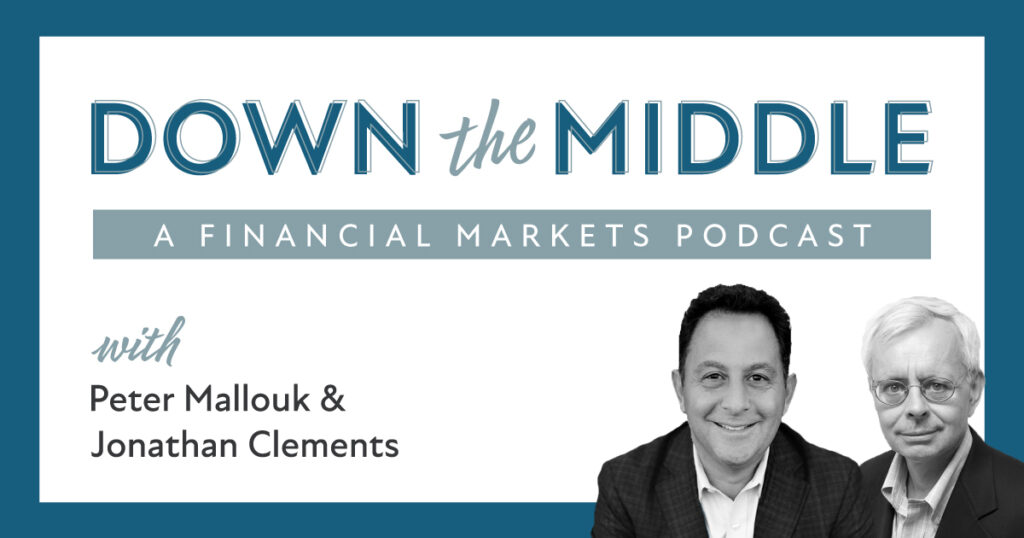This month, Peter Mallouk and Jonathan Clements discuss inflation’s effect on everything from bonds to home prices and what actions you should — and should not — take to potentially mitigate your risk.
Hosted by Creative Planning Director of Financial Education, Jonathan Clements, and President, Peter Mallouk, this podcast takes a closer look into topics that affect investors. Included are in-depth discussions on financial planning issues, the economy and the markets. Plus, you won’t want to miss each of their monthly tips!
Have questions or topic suggestions?
Email us @ podcasts@creativeplanning.com
Transcript:
Jonathan Clements: Hi, this is Jonathan Clements, Director of Financial Education for Creative Planning in Overland Park, Kansas. With me is Peter Mallouk, president of the firm, and we are Down The Middle.
In recent podcasts, Peter and I have talked multiple times about inflation and the implications for the stock and bond markets, but today, we’re taking a slightly different tack, and talking about what inflation means for our broader financial life.
So, let’s start with debt. Inflation, as we all know, is bad for most bond investors because it eats away the spending power of their holdings and the interest they receive, but if inflation is bad for bond investors, presumably it’s good for those who are in debt because they get to repay their loans with depreciated dollars. So, Peter, is this something that folks should be actively looking to take advantage of?
Peter Mallouk: I’m glad we’re talking about this because we talk about inflation because of the supply chain. And inflation because China’s shutting down over COVID again or it’s deglobalization because of Ukraine, or it’s all the stimulus money. But the reality is, people have to live in this environment, and today I’m glad we’re covering, what do you actually do in an environment like this?
And we always hear that bonds are bad in an inflationary environment. And a bond is just a loan, right. You loan money to the federal government, treasury, you loan it to a county or state, it’s a muni, municipal bond. If you loan it to a corporation like McDonald’s, it’s a corporate bond. And you loan it to a company in trouble, it’s a high yield bond.
But when you’re loaning money to those parties in a format of a bond, it’s usually a fixed rate, right. So you loan money to the federal government, they go, “Great, here’s your 2.5% a year.” And we say bonds are bad in an inflationary environment because if the costs of things are going up 7% a year over the next, say, 10 years, and you’re only collecting 2.5%, you are losing money. You’re losing the purchasing power of your money.
Well, the other side of that is if you’re the one borrowing. If you’re on the borrowing side of a loan instead of the lending side of a loan, inflation is good. It can’t be bad for one side and bad for the other. So, if I’m a bank and I’m collecting 3% on a mortgage for 30 years and inflation’s is 6%, it’s not the greatest deal of the world. But if I’m the guy with the mortgage and I’m only paying 3% and my home is going up in value at 6% a year, that’s positive.
So, a lot of people in inflationary environments, they go borrow money. Do I think it’s a good idea? Generally, no. From a wealth accumulations standpoint, it’s great, but in high inflation environments, the Fed takes action to try to control rates and the market can become increasingly volatile. We’re seeing that now. And when you add leverage to your life, whether you borrow against your house or you borrow against a duplex you’re renting out, or you borrow against your portfolio, you’re increasing risk, you’re increasing volatility, you’re opening up more negative scenarios that can happen. So, I think if you’ve got a stable asset, very long period of time like a house, yeah, it’s going to be great to have if you could get a 3% mortgage for 30 years. Don’t exist today. But if you get a very low mortgage for a very long period of time in an inflationary environment, you’re going to be rewarded. But going out and borrowing against everything like some people do in an inflationary environment, can be extremely stressful and can backfire.
Jonathan: So, rather than rushing out and taking on a lot of debt, of course, what a lot of people do is they pay ahead on their loans. They have a mortgage and they make extra principal payments every month. And in the past, that hasn’t been a bad strategy, but we now may be moving to that tipping point where there are a lot of people out there who have 3% mortgages. We’ve now got bond yields creeping up, and what they’re going to discover is that they can better improve their financial position by not making those extra principal payments on their mortgage, and instead turning around and buying bonds.
We’re getting to the point where bond yields are going to start rising above, say, that 3% threshold, and so that’s where the arbitrage lies. You sit there every month and say, “Where am I going to put my extra $1,000 of savings? Should I put it towards the mortgage or should I put into the bond market?” And we’re getting to the point where putting it into bonds doesn’t seem like such a bad idea.
Peter: Yeah, we haven’t had that tipping point in decades. And here we are where it’s going to be coming upon us where that arbitrage opportunity is going to be available to a lot of people.
Jonathan: So, actually, talking about mortgages, historically, real estate has been a great inflation hedge. It’s just that inflation erodes the real cost of that mortgage debt, but also on top of that, home prices historically have risen about one percentage point a year faster than inflation. So, again, given that we’ve seen inflation picking up, Peter, does this mean that people should go out and buy a second home? Should they go out and buy a larger home? Is that the way that we should play the current inflation rate?
Peter: Yeah, I actually have seen a lot of this. Like, “I’m buying a second home because homes are going up 10, 15% a year.” That’s not how it works usually with homes. There are some exceptions. If you’re listening to this in Austin, Texas, where it seems like every year housing prices go up 15% to 35%, but in general, houses do nothing for very long periods of time. To your point, they just basically stay with inflation, but of course, they have a carrying cost. And then they have these periods where they really leap in high inflation environments like before the ’08/’09 crisis, or where we are today. But homes are different kind of assets than other assets. If you’re the owner of things like stocks or a home or a rental property, those sorts of things tend to go up in inflationary environment.
The difference is a second home carries a carrying cost. You’re paying the maintenance, the insurance, the taxes. So, even if you have those big gains, they really do get offset. A second home decision, even in an inflationary environment, should really be around, do you want to go to the same place over and over, build memories in that location? If so, wonderful. If you can afford it, by the second home, but you buy it for the emotional benefit, which is the best reason to buy anything, not for the financial benefit. There are other much more profitable ways to offset inflation.
Jonathan: Another issue for people caused by inflationary environment is if they’re retired. They’re there trying to cover their rising expenses using their investment portfolios over retirement of uncertain length. To me, retirees are the group most threatened by the spike in inflation that we’re seeing. Historically, Peter, people talk about things like a 4% portfolio withdrawal rate. Are the traditional strategies for generating retirement income still the same in this sort of environment? Should people be spending less? What’s the best advice for retirees at this point?
Peter: I think, generally, if you’re a Creative Planning client listening to this podcast, you likely don’t have this issue. But generally the average American is far too conservatively invested in retirement. Now, most retirees go, “I’m retired. My time horizon is zero. I’m retired. Or “I’m retiring in one year. My time horizon’s one year.” And therefore I’m going to have a huge percentage in bonds, 50%, 60%, 70% or a large amount in cash. And you just get destroyed in high-inflation environments like now where what $1 million can buy today, you only needed $800,000 to buy it a year ago. I mean, you cannot be all in bonds in cash.
At Creative we have always taken the bias of only having the money in fixed at income assets that you need to get through a crisis. And the rest we want to be owners of assets like stocks. And the reason is there is generally an inflationary trend, and stocks keep you ahead of inflation. They keep the purchasing power of that portfolio in place. Your time horizon if you’re retired is not over. For most people that are retired, they have decades that we need this portfolio to work. So that ownership bias has paid off really well for our clients over the last 20 years. That’s the position we’re going to take going forward for the reasons you just articulated.
Jonathan: And so, for a retiree today who has a bond-heavy portfolio, making a subtle shift in their portfolio, maybe allocating more to stocks, this probably isn’t a bad time to be making that shift. Yeah, we’ve got the bond market down, but also the stock market at this point is down even a little bit more.
Peter: Yeah. I mean, we’ve had…I think that most of our clients have made this shift many, many years ago and they have all of the stocks that they need. But when you get through any correction like the one that we’re going through now is a great time to evaluate, can you really handle it? And if you can handle getting through a correction, revisit with your wealth manager, “Do I only have the bonds I need?” And the rest is invested for the long run. That’s the posture to take for very long-term success.
Jonathan: So I promised you, Peter, that I wouldn’t let this podcast run too long. So, let’s cut to the end of the podcast and it’s time for your tip of the month. What have you got for us, Peter?
Peter: All right. Well, home prices have really rocketed. And so, if you have a home, you have homeowner’s insurance, make sure your insurance actually covers the value of your home. A lot of people bought a home for $700,000 and just wake up and now it’s a $1.2 million house, but you might still have a policy covering a $700,000 house. And if God forbids something happens, you’re not really covered. So, make sure to check that coverage and make sure that it’s appropriate for the value of your home today.
Jonathan: Yeah, that’s great advice after the big home price gains that we’ve seen. Meanwhile, my tip of the month is really very simple. If you’ve got a lot of cash sitting in your checking account, find some place to put it. Even moving from your checking account where you’re going to be earning zero interest to a high-yield online savings account, where you’re getting 0.6%, that’s going to be an improvement. Yeah, you’re still going to be losing ground to inflation, but at least you’re not losing quite as much ground. Also in the months ahead, should see money market fund yields start to rise. So if you want to take that cash out of your checking account and move it to your brokerage firm, there, you should start to get a decent amount of interest in the months ahead. This is the moment when you don’t want to be sitting on a pure cash. You want to be making at least a little bit of money on the cash that you have. So that’s it for this month, Peter. This is Jonathan Clements, Director of Financial Education for Creative Planning. I’ve been talking to Peter Mallouk, President of the firm, and we are Down The Middle.
Disclosure: This commentary is provided for general information purposes only and should not be construed as investment, tax or legal advice. Past performance of any market results is no assurance of future performance. The information contained herein has been obtained from sources deemed reliable but is not guaranteed.





